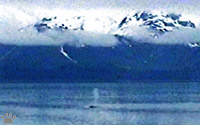
Lone humpback whale in Glacier Bay, Alaska.
Marine Mammals
Various species of whales, dolphins, seals and other mammals
occur in all of the World's seas, as well as in some rivers and lakes, but there
are few "hotspots" where you can see many species in great numbers.
Most of them are areas of high biological productivity in parts of the ocean where
warm and cold waters mix up. I've been lucky to see some of the best marine mammal
habitats. Below are some photos and site descriptions.
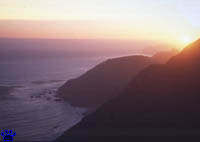 Coast of California near Lucia.
Coast of California near Lucia. |
The most diverse fauna of marine mammals
outside Antarctica can be found in Northern Pacific Ocean, particularly along
the coast of California, where cold current enters
subtropical waters. |
 Seals waiting out a storm, Salt Point, California.
Seals waiting out a storm, Salt Point, California. |
 Farallone Islands near the entrance
Farallone Islands near the entrance
to San Francisco Bay - another great
place to see various whales, dolphins,
seals and sea lions. |
The best place to see marine mammals
in California is Monterey
Bay. It is extremely productive area; besides, giant underwater canyons near
shore give you a chance to see some species rarely encountered in coastal waters,
including such deepwater specialist as sperm whale. |
 Feeding group of humpback whales,
Feeding group of humpback whales,
dolphins of three species,
sea lions and various seabirds.
Monterey Bay, California. |
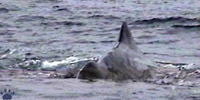 |
 |
 |
| Sperm whale (Physeter
catodon), large male, Monterey Bay. It can be easily recognized at sea: its
blow is directed sideways, not upwards. |

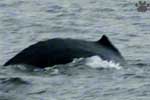
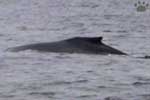
Migrating humpbacks,
Monterey Bay. |
More than 30 species of marine
mammals can be seen in Monterey Bay. Some of them are common in appropriate season,
others are rare visitors. Humpback whales (Megaptera novaeangliae) are
probably the most spectacular. They show endless variety of interesting behavior,
such as singing, breaching and bubble-netting, and are very curious and playful.
They are easy to find in summer and early fall, but move south in winter.

Humpbacks can be identified by the unique pattern
on the underside of their tail. |
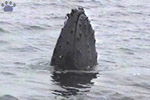
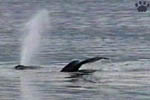
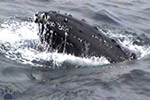
Humpbacks playing with kelp,
Monterey Bay. |
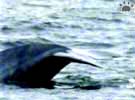 Blue whale, Monterey Bay.
Blue whale, Monterey Bay. |
Another common summer resident is blue
whale (Balaenoptera musculus). Monterey Bay is the best place in the World
to see these beautiful giants. It is estimated that at least 25% of these rare
whales spend summer in Californian waters. |
 Blue whale, Monterey Bay.
Blue whale, Monterey Bay. |
 Blue whale (B. musculus),
Blue whale (B. musculus),
Monterey Bay.
 Fin whale (B. physalus), Paramushir,
Fin whale (B. physalus), Paramushir,
Kuril Islands. |
Three other species of Balaenoptera
whales (rorquals) can be occasionally seen in Monterey Bay, but they are more
easy to find in other places, such as Barents Sea or Kuril Islands. They differ
in size and coloration, but can be difficult to identify at sea. Relative size
of dorsal fin can be used to tell them apart. |
 Sei whale (B. borealis), Kildin
Sei whale (B. borealis), Kildin
Island, near Murmansk, Russia.
 Minke whale (B. acutorostrata),
Minke whale (B. acutorostrata),
Monterey Bay. |
 Baird's beaked whale (Berardius bairdi),
Baird's beaked whale (Berardius bairdi),
Monterey Bay. |
Even beaked whales (Ziphiidae),
little known and usually very difficult to see, can occasionally be found in Monterey
area. |
 Baird's beaked whales (Berardius bairdi),
Baird's beaked whales (Berardius bairdi),
Monterey Bay. |
| At least seven species of beaked whales
occur in the Pacific Ocean off California. They prefer deep waters far offshore.
Some are only known from a handful of beached specimens, others are more regularly
observed. |
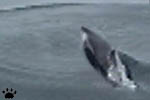
Perrin's beaked whale, appr.
100 nm west from San Francisco. |
This video snapshot (left, slightly enhanced
in Adobe Photoshop) is almost certainly the first and only image of recently (2002)
described Perrin's beaked whale (Mesoplodon perrini) ever obtained in the
wild. |
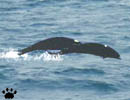 Northern right whale dolphins
Northern right whale dolphins
(Lissodelphis borealis), bow-
riding, Monterey Bay. |
 |
 |
 |
| Risso's dolphins (Grampus griseus),
Monterey Bay.
|
Three dolphin species shown here occur in the Bay in giant mixed herds year-round.
They can be found throughout the North Pacific, but seldom so close to shore. |
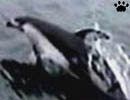 Pacific white-sided dolphin
Pacific white-sided dolphin
(Lagenorhynchus obliquidens),
bow-riding, Monterey Bay. |
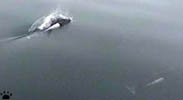 Dall's porpoise (Phocoenoides dalli),
Dall's porpoise (Phocoenoides dalli),
Monterey Bay. |
Dall's porpoise, another local resident,
is the World's fastest cetacean, and also the most maneuverable one. These two
photos were taken only one second apart. |
 Dall's porpoise (Phocoenoides dalli),
Dall's porpoise (Phocoenoides dalli),
Monterey Bay. |
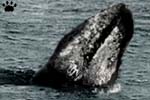 Gray whale, Monterey Bay.
Gray whale, Monterey Bay.
 Gray whales (mother and calf)
Gray whales (mother and calf)
below Point Reyes Lighthouse. |
Only three species of cetaceans can
be regularly seen from shore in California: bottlenose dolphins (Tursiops truncatus)
in Monterey Bay area, short-beaked common dolphins (Delphinus delphis)
around San Diego, and gray whales (Eschrichtius gibbosus) all along the
coast. These small whales pass by as they migrate from Alaska to Mexico in winter,
and back north in spring. Occasionally mothers give birth to calfs in Monterey
Bay. Point reyes Lighthouse is the most reliable place to look for them from shore. |
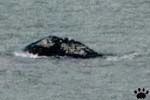 Gray whale, Monterey Bay.
Gray whale, Monterey Bay.
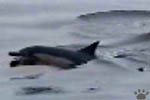 Long-beaked common dolphin
Long-beaked common dolphin
(D. capensis), off Point Pinos. |

Short- and long-billed
common dolphins, off Ventura. |
Short- and long-billed common dolphins
usually don't mix together. So I was very surprised to encounter a large mixed
herd off Ventura in May 2003. It also included some Pacific white-sided dolphins
and humpback whales. |

Short-billed common
dolphin, Monterey Bay. |
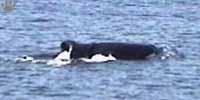 |
 |
 |
 |
| Flapfin - a male from
a pod of so-called transients, whale- and seal-hunting killer whales, Monterey
Bay, California. |


Female killer whale chasing Pacific
white-sided dolphins. Off Point Pinos.
a


Killer whales can be identified by the shape
of their dorsal fins and whitish saddle
patches. Off Point Pinos. |
Killer whales (Orcinus orca)
of California belong to three different cultures, each with its own language,
behavior, and migration patterns. Transient pods patrol the coast in search
of marine mammals, or ambush gray whales during migration. Residents feed
on salmon and herring, live in Puget Sound and other inshore areas further north,
but occasionally come south to Monterey Bay in winter. Offshores live in
the open ocean in large herds, feeding on pelagic fish and squid; their habits
are mostly a mystery. Interestingly, local sea lions and other wildlife can clearly
tell these groups apart by sight and sound. |


Transient orcas - male, female, and calf.
Off Point Pinos.
a


Transient orcas tend to have more pointed
dorsal fins than offshore ones. Male above -
off Point Pinos, male below - off Farallones. |
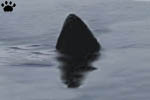
Fin of basking shark (Cetorhinus maximus), Monterey Bay.
Part 2: California (continued)
Home
|